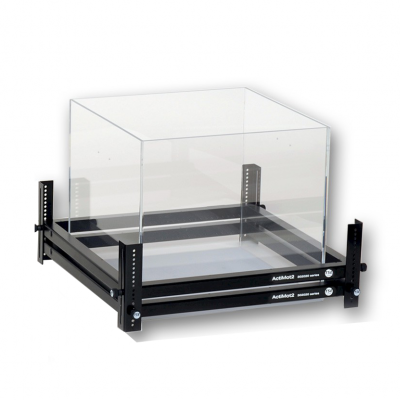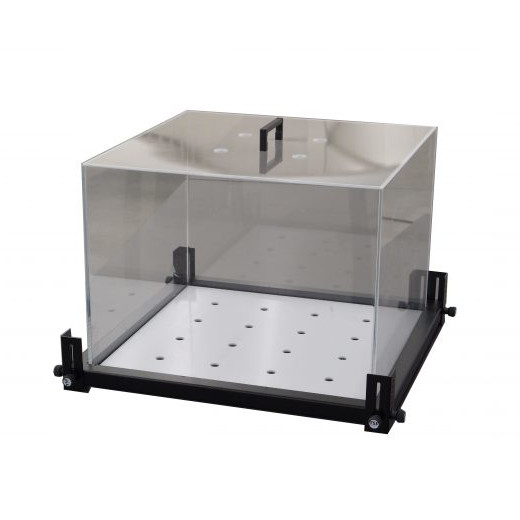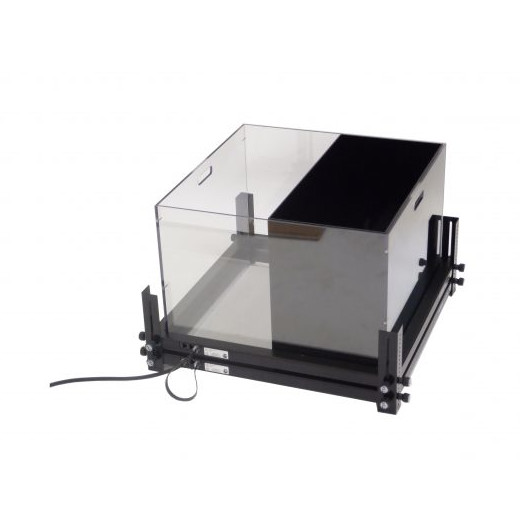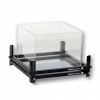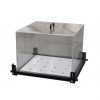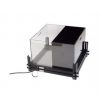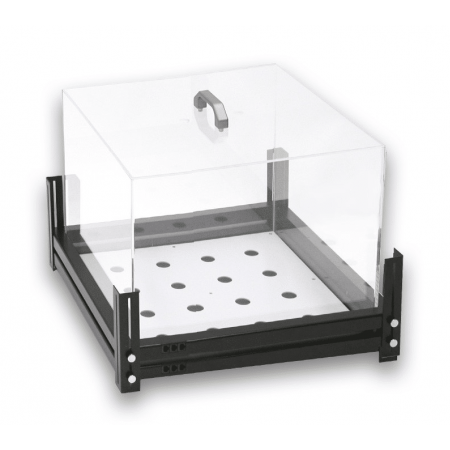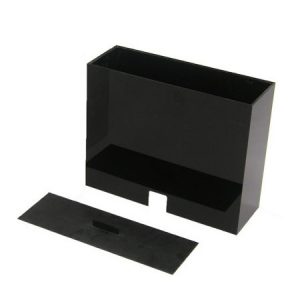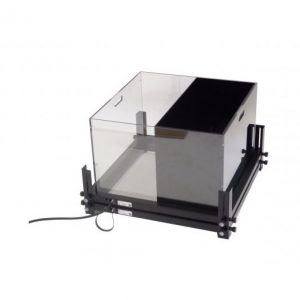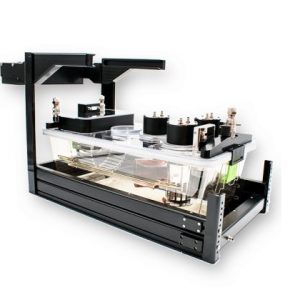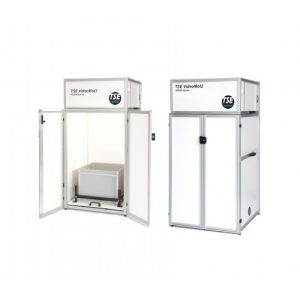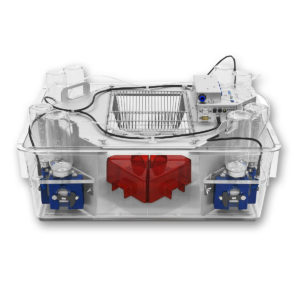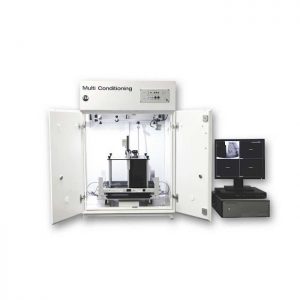Product Enquiry
If you would like to send us an enquiry about this product, please click the button below, fill in the form and submit.
Product EnquiryActiMot2
Infrared Light-Beam Activity Monitor
The multi-purpose ActiMot2 system registers animal movement in a homecage or a special arena with a 3-dimensional grid of light-beam sensors. Horizontal and vertical movements are reliably detected with high spatial and temporal resolution.
ActiMot is available for Open Field experiments to study spontaneous activity, exploration, and anxiety (ActiMot2). Square-shaped light-beam frames in two sizes with up to two additional rearing levels are combined with Open Field arenas for rats and mice. The dedicated ActiMot “Advanced” software with more than 100 integrated results parameters is customized with various inbuilt options, including definition of regions of interest and detection thresholds to finetune activity and speed parameters. Hole Board floors to study exploration, Light-Dark inserts for tests on unconditioned anxiety and Place Preference arenas to evaluate the aversive/addictive properties of drugs are available as optional components.
ActiMot can be also configured to study long-term activity in homecages under stress-free conditions with the PhenoMaster platform (ActiMot3).
Features
- Flexible use for different arenas
- Activity detection in three dimensions (X-Y-Z axis)
- Up to 2 rearing levels
- High spatial and temporal resolution
- Detailed comprehensive numerical and graphical analysis
Application
- Activity
- Exploration
- Anxiety
Modules
- Hole Board
- Light-Dark Test
- Open Field
- Place Preference
Selected Publicatons:
Castañeyra-Ruiz L, Castañeyra A, González-Santana A et al. Combining the lack of chromogranins with chronic L-DOPA treatment affects motor activity in mice. Cell Tissue Res 2020; 380: 59–66
Cruces-Solis H, Nissen W, Ferger B, Arban R. Whole-brain signatures of functional connectivity after bidirectional modulation of the dopaminergic system in mice. Neuropharmacology 2020; 178: 108246
Talamonti E, Sasso V, To H, Haslam RP, Napier JA, Ulfhake B, Pernold K, Asadi A, Hessa T, Jacobsson A, Chiurchiù V, Viscomi MT. Impairment of DHA synthesis alters the expression of neuronal plasticity markers and the brain inflammatory status in mice. FASEB J 2020; 34(2): 2024-40
Varshney MK, Yu NY, Katayama S, Li X, Liu T, Wu WF, Töhönen V, Krjutškov K, Kere J, Fan X, Inzunza J, Gustafsson JÅ, Nalvarte I. Motor Function Deficits in the Estrogen Receptor Beta Knockout Mouse: Role on Excitatory Neurotransmission and Myelination in the Motor Cortex. Neuroendocrinology 2021; 111: 27-44
Selected Product Citations
Synergistic Effect of Feeding Time and Diet on Hepatic Steatosis and Gene Expression in Male Wistar Rats |
|
| Johanneke E.Johanneke E. Oosterman Oosterman, Laura L.Laura L. Koekkoek Koekkoek, LeslieLeslie Eggels Eggels | Obesity Silver Spring | Published 31 May 2020 |
| Article Snippet Fat and carbohydrate oxidation were calculated manually according to Bruss et al. ( ).. Locomotor activity was measured with ActiMot2 (TSE Systems GmbH) light beam frames.. After measurements in the calorimetric cages, animals were returned to their home cages for the remainder of the experiment. |
|
Thermoneutral Housing Temperature Improves Survival in a Murine Model of Polymicrobial Peritonitis |
|
| Kelsey C. Carpenter, Yesen Zhou | Shock | Published 15 May 2020 |
| Article Snippet Prior to experimental use, mice were acclimated for at least 5 days in ventilated microisolation cages in a temperature-controlled room kept at 22.2°C ± 1.1°C and relative humidity of 60% ± 10%.. After CLP, mice were housed three to five per cage in static microisolation cages in specialized climate chambers (TSE ActiMot2 303021 series) set to 22°C or 30°C.. Relative humidity was set to 60%. |
|
Motor Function Deficits in the Estrogen Receptor Beta Knockout Mouse: Role on Excitatory Neurotransmission and Myelination in the Motor Cortex |
|
| Mukesh Kumar Varshney, Nancy Yiu-Lin Yu | Neuroendocrinology | Published 28 Jan 2020 |
| Article Snippet cm; TSE Systems, Bad Homburg vor der Höhe, Germany) facing the wall and was allowed to freely explore the cage, with the experimenter observing the animal on a video feed in an adjacent room, out of the animal’s sight. … The animal’s locomotor and rearing activity as well as the time spent in the center (25 × 25 cm square) and periphery (considered everything else than the center square) was recorded using lower and upper (3 cm apart) infrared beams dividing the arena into 256 equally sized squares and analyzed using the ActiMot2 software (TSE Systems).. Entry into the central or peripheral zone was defined as the movement when the mouse placed all of it paws into the respective zone. |
|
View more citations at the TSE website
Modules
Hole BoardExploration Test
The Hole Board exploration test is a behavioral paradigm especially used in mice. The animal is placed on a floor equipped with a symmetrical arrangement of holes. Head dipping into these holes is used as a measure of exploration. The effect of stress, anxiety, or drugs targeting different neurotransmitter systems on head dipping behavior is evaluated. The multi-purpose ActiMot2 system can be configured for Hole board experiments. A Hole Board with species-specific hole size is placed into an Open Field. With a grid of infrared sensors mounted below the board, hole visits are reliably detected using the Hole-Board plug-in of the comprehensive “ActiMot2 Advanced” software package. Gross activity on the board can be assessed by adding an additional sensor level that is located above the board. For detailed movement analysis on the board add a second 2-dimensional sensor frame and/or an optional rearing detector. TSE Systems also provides a cost-effective stand-alone “Hole-Board-Only” software that can also be configured for a spatial version of the Hole-Board test that uses baited holes. The Hole Board exploration test can also be configured in a Multi Conditioning setup. Features
Applications
Selected PublicationsBouter Y, Brzózka MM, Rygula R, Pahlisch F, Leweke FM, Havemann-Reinecke U, Rohleder C. Chronic Psychosocial Stress Causes Increased Anxiety-Like Behavior and Alters Endocannabinoid Levels in the Brain of C57Bl/6J Mice. Cannabis Cannabinoid Res 2020; 5(1):51-61 Brzózka MM, Rossner MJ, de Hoz L. Tcf4 transgenic female mice display delayed adaptation in an auditory latent inhibition paradigm. Eur Arch Psychiatry Clin Neurosci 2016; 266(6): 505-12. |
Light-Dark TestUnconditioned Anxiety
The light-dark paradigm is a widely used quick and easy test on unconditioned anxiety (trait anxiety) in rodents that does not require prior training. It is based on a conflict between the innate aversion to a brightly lit area and the spontaneous exploratory drive in response to a novel environment. If given a choice between a brightly lit and a dark compartment, rodents spontaneously prefer the dark. Anxiolytic compounds increase the time spent in the bright compartment – anxiogenic compounds work the opposite way. Special dark inserts made from infrared permeable acrylic material can be placed into the ActiMot2 Open Field to quickly convert the Open Field into a Light-Dark test arena. Inserts are available in 50% or 33% size – the smaller insert increases the aversiveness of the bright area. The dark insert has a central opening in species-specific size – a manually operated door is available as an option. The movement of the animal between compartments is monitored with the high-resolution ActiMot2 light-beam frame. The ActiMot2 software package offers a large variety of dedicated results parameters calculated from these movement data. In addition to the standard parameters latency to enter the dark or bright compartment (depending on the start position) as well as the total time of stay and entries in both compartments many more behavioral measures are provided as compared to other systems that rely on simple transfer detection only. Output rearing as a measure of exploration (up to 2 rearing levels are possible), calculate activity periods, use custom zones to further divide the area into regions of interest, display a pattern of movement – the advanced analysis features allow a comprehensive analysis of the anxiety state of the animal. The Light-Dark paradigm is also available in the TSE VideoMot2 system and the TSE Multi Conditioning system. Features
Application
Disease model
Selected PublicationsDurairaja A, Fendt M. Orexin deficiency modulates cognitive flexibility in a sex-dependent manner. Genes Brain Behav 2020; 17: e12707 Bouter Y, Brzózka MM, Rygula R, Pahlisch F, Leweke FM, Havemann-Reinecke U, Rohleder C. Chronic psychosocial stress causes increased anxiety-like behavior and alters endocannabinoid levels in the brain of C57Bl/6J mice. Cannabis Cannabinoid Res 2020; 5(1):51-61 |

